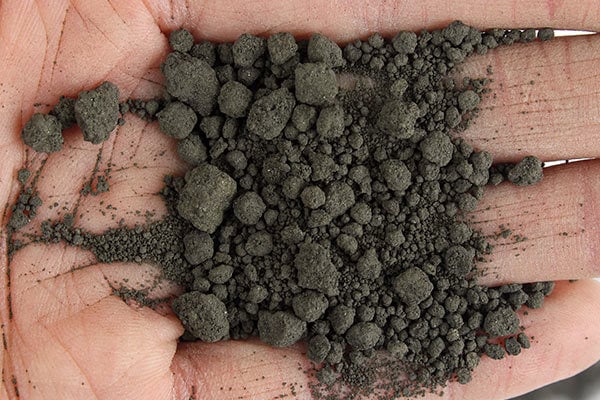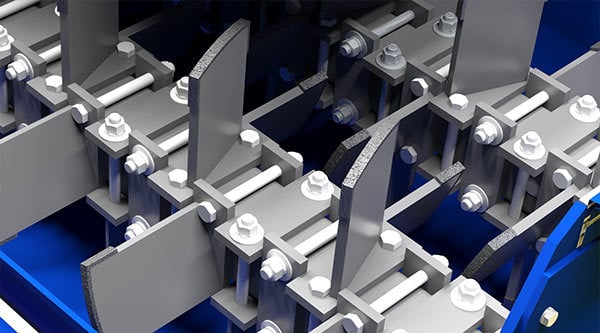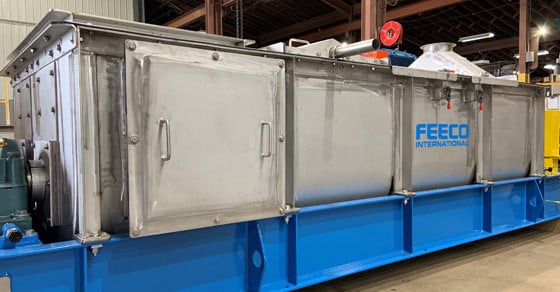The pugmill mixer, also known as a pug mill or paddle mixer, is a type of horizontal industrial mixer used for processing bulk solid materials in conditioning, de-dusting, and granulation applications. This type of mixer is widely employed throughout various industries as a means of preparing material for downstream production activities, processing materials for improved handling, as well as conditioning materials for deposit into landfills.
The following provides answers to some of the most frequently asked questions (FAQs) surrounding pugmill mixers.
Does a pugmill mixer create granules?
Yes: In addition to mixing liquid and solid feedstocks into a homogeneous mixture and accommodating chemical reactions, the pugmill mixer is also capable of producing granules.
When granulation is desired, production is controlled both by the overall sizing of the unit, as well as the adjustment of process parameters based on the characteristics of the material being processed.
What is the typical material consistency exiting the mixer?
The typical consistency of material exiting the pugmill mixer is rough agglomerates mixed with conditioned/de-dusted fines. However, processing parameters such as binder/liquid spray rate, retention time, and more, can all be used to control the consistency of the material exiting the unit, promoting more or less agglomeration.

Material after processing in a pugmill mixer (paddle mixer)
What mode of action does the pugmill mixer use?
The pugmill mixer is a medium-sheer mixer that imparts a kneading and folding motion on material. The counter-rotating twin shafts cause material to be “lifted” up between the two shafts and then sent down the sides of the u-shaped trough. In addition to the mixing that occurs as a result of this action, mixing also occurs between paddles as they pass by each other in the center of the mixer.
A “pulling” motion occurs along the trough walls as the shafts rotate that causes material to advance toward the discharge end of the mixer.
Are pugmill mixers batch or continuous?
Pugmill mixers are a continuous mixer. Some manufacturers may offer them at a batch-processing capacity, but these small-scale mixers are better suited for R&D activities and not commercial-scale production. Continuous units are capable of processing up to 250 TPH.
What are the differences between a pugmill mixer and a pin mixer?
While there is some overlap between these two types of mixer, there are several differences between them that generally makes one or the other better suited to different types of applications.
In contrast to the intense centrifugal motion that occurs in a pin mixer, kneading and folding action used by the pugmill mixer is still considered medium sheer, but is less intense than the pin mixer. For this reason, granules produced in a pugmill mixer are less dense than those produced in a pin mixer.
Combined with a higher torque, the pugmill mixer’s action is ideal for processing more malleable or sticky materials such as sludge, as well as materials that are highly abrasive, or that consist of large clumps.
In addition to their different mode of action, pugmill mixers are also capable of processing a much higher capacity than pin mixers. They also have a longer retention time, making them better for accommodating chemical reactions.
Pugmill mixers also allow for a bit more flexibility in processing, in that the paddles can be adjusted to modify the mixing pattern.
How do you adjust the paddles?
Pugmill mixers are unique in that they allow the mixing intensity and retention time to be adjusted by modifying the paddle arrangement. This is helpful when a change in operating conditions or feedstock characteristics occurs, allowing operators to adjust accordingly. Paddles are affixed to the shafts via bolts, making removal and replacement a simple task.
Achieving the right outcome when adjusting paddles is often a process of trial and error. In addition to the overall arrangement, paddle proximity can be adjusted to bring paddles closer together or push them farther apart. The most common paddle adjustment involves removing or reversing some of the paddles.
Paddles are reversed by swapping paddles in pairs from one shaft to the other, removing one paddle from the right shaft, and replacing it with the same paddle from the left shaft and vice versa. This allows paddles that were previously pushing material toward one end of the mixer to push material toward the opposite end, thereby increasing retention time.
By removing one or more pairs of paddles pushing toward the discharge, retention time can be increased without significantly increasing mixer brake horsepower. Retention time and mixer intensity can be increased by reversing one or more pairs of paddles pushing toward the discharge end of the mixer.
In adjusting paddle arrangement, care must be taken to ensure that the paddles are positioned so that the lined side of the paddle (if applicable) is the side that pushes against the material.

3D rendering of the interior of a pugmill mixer showing paddle attachment and arrangement
What is the material retention time?
A typical retention time is around 60 seconds, with the exact retention time depending on the material’s unique characteristics, as well as the process goals – whether or not granulation is desirable, end product consistency, etc.
What are the normal wear items?
Pugmill mixers generally have few wear parts, with paddles being the most commonly worn items. Other components that might require replacement throughout the mixer’s life due to wear include:
- Pinions
- Shafts
- Sprockets and drive chain
- Seals
What are the benefits of using a double shaft over a single shaft pugmill mixer?
While some manufacturers offer single-shaft pugmill mixers, all FEECO pugmill mixers are of the dual-shaft design.
Pugmill mixers with a dual-shaft design promote the intimate contact of solid and liquid feeds necessary to produce a homogeneous mixture. If only a single shaft were used, the kneading and folding motion this mixer type is so well known for would be negated.
For this reason, pugmills with a dual-shaft design can offer more thorough mixing, resulting in a more homogeneous mixture. The intimate contact created between particles that results from the counter-rotating shafts also promotes a more complete reaction where applicable.
It is for these reasons that the pugmill is the preferred device for processing copper concentrates prior to smelting.
How do I know if a pugmill mixer is the right mixer for my application?
While pugmill mixers provide an excellent processing solution for many materials, they are not a fit for all applications. The specific characteristics of the feedstock, as well as the desired end product parameters and process goals may call for a different agglomeration solution.
Determining whether or not this type of mixer is the best fit for a given application is best established through testing, either through testing in a facility, or through utilizing a rental pugmill mixer.
Facilities such as the FEECO Innovation Center provide initial feasibility testing to evaluate the best agglomeration system for a project, as well as continuous pilot-scale testing for identifying the process parameters necessary for reaching the end product goals.
Through testing, it may be established that another approach such as a granulation drum (rotary granulator) may be better suited to the application.

Feasibility testing being carried out in a pugmill mixer in the FEECO Innovation Center
Conclusion
Pugmill mixers serve an important role in a wide array of industrial processes, helping to mix, condition, and agglomerate various types of bulk solids.
In business since 1951, FEECO provides the industry’s most robust and reliable pugmill mixers. All FEECO pugmills are customized to meet the specific process and material goals of the application at hand. To find out if the pugmill mixer is a good fit for your processing application, contact us today!



